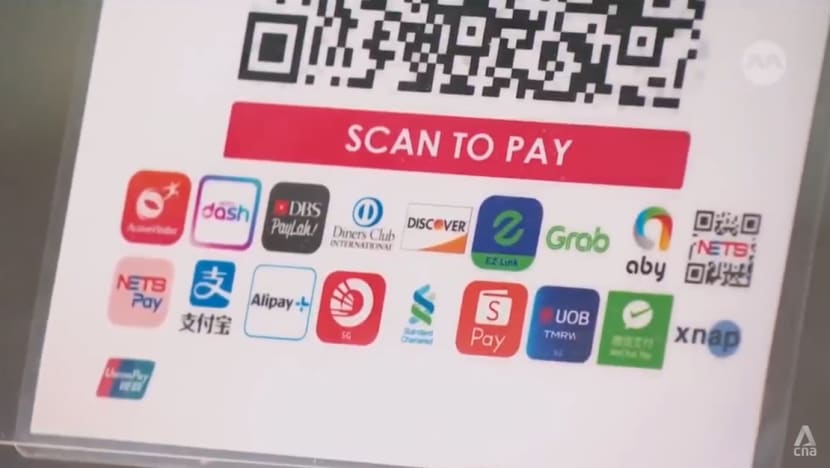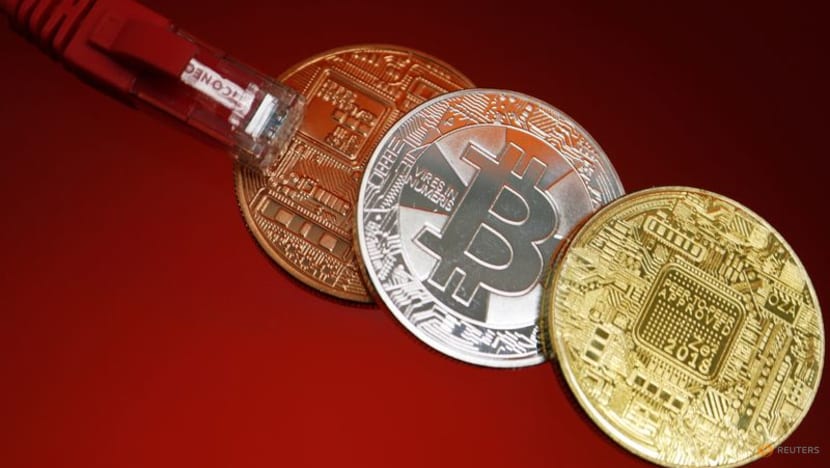Commentary: Asian consumers could soon be paying with stablecoins
Singapore and Hong Kong want to license blockchain tokens in an effort to make them useful in everyday life, says Andy Mukherjee for Bloomberg Opinion.

A QR payment label displays the payment options available.
This audio is AI-generated.
HONG KONG: In the decade that they have been around as an asset class, crypto stablecoins, which advertise tranquility in an ocean of tumult, have hardly lived up to their billing. Not one out of the 68 tokens studied by researchers at the Bank for International Settlements has managed to stay on its peg at all times.
Tether and USD Coin, the two largest players, reference their values 1:1 to the dollar, which enables them to act as a bridge of sorts between virtual and real-world representations of money. However, they have very little use outside the domain of crypto trading. For the broader population that doesn’t dabble in Bitcoin or Ether, keeping money in a bank that has deposit insurance has always been a safer option.
And yet, despite their well-known infirmities, more stablecoins keep coming. Regulators, too, seem to be more receptive to having them around, despite spectacular blowups like when TerraUSD breached its US$1 price target in May 2022 and wiped out about US$500 billion from cryptocurrency markets. Circle’s USD Coin briefly lost its peg during the US regional banking crisis of 2023.
Still, Hong Kong put out a proposal last week to license stablecoins. Singapore has already announced similar intentions. It’s very likely that before the end of 2024, the two financial centres will have come up with rules that US lawmakers have failed to adopt after three years of efforts.
Both Asian jurisdictions seem to think that they can tame at least one sub-species of the unruly beast, the one that promises conversion into a fiat currency and backs that promise by maintaining liquid, safe reserve assets in that currency.
PURPOSE-BOUND MONEY, THE NEW BUZZWORD
With pragmatic regulation, such stablecoins can operate as an efficient payment option in everyday situations that have nothing to do with crypto trading. The buzzword is purpose-bound money, which can wrap a layer of programming around the value stored as tokens and direct it to a specific end.
Take the case of a Chinese tourist in Singapore. She wants to pay in yuan from her Alipay+ e-wallet, but the merchant only accepts GrabPay. Enter XSGD, a digital form of the Singapore dollar that is privately issued and can be made to fulfill conditions specified by an algorithm.
In this particular example, the computer code will direct Alipay+ wallets to release funds in Singapore, but only for buying goods and services from a merchant that uses GrabPay – a clearly defined purpose. However, once the sellers have received their XSGD tokens and cashed them for equivalent Singapore dollars, they’re free to do whatever they want with the money.
StraitsX, the issuer of XSGD, will close the payment loop by collaborating with Ant Group and Grab Holdings. The Chinese tourists won’t need to deal with Grab, and the Singaporean merchants won’t need to maintain a relationship with Ant.
Cross-border transactions will go through in an instant without small businesses being saddled with expensive credit card fees. At the same time, by defining the payment purpose – and imposing prudential limits on transfers – regulators will ensure that stablecoins don’t end up becoming new channels for money laundering.
In addition to traditional payment methods, such as bank accounts or physical cash, people will broadly have three choices. They could settle claims using central bank digital currencies (CBDCs), once they become available.
Or their banks would allow them to tokenise deposits and make advance payments – toward a rental agreement, for instance – but only when the other party fulfills its contractual obligation. Alternatively, payers and payees could use stablecoins, provided they trust them to hold their value even if their private issuers go bankrupt.
TRANSPARENCY AND CONSUMER PROTECTION
Which is why the thrust of the emerging stablecoin regulation in Asia (and Europe) is on transparency and consumer protection.
According to the paper Hong Kong has circulated for public consultation, issuers will have to disclose the value of their assets and liabilities each day. They must break down the composition of their reserve assets every week and produce an auditor’s report once a month.

This is an improvement on the status quo. For instance, Tether publishes its reserves daily but only supplies a quarterly assurance opinion by an accounting firm. Investors can ask the platform to give them cash in exchange, but they need to surrender the equivalent of at least US$100,000 in coins.
According to rules currently under discussion in Hong Kong, firms can’t discourage redemption of tokens by keeping the threshold amounts or fees too high. They would also need to bring in capital up to 2 per cent of the par value of the coins they put in circulation.
These licensed players won’t be allowed to get into risky side hustles like lending. They will earn interest on reserve assets and pay nothing to coin holders.
The Monetary Authority of Singapore (MAS) finalised a similar set of rules in August. The key difference is that while Hong Kong appears inclined to also permit stablecoins that target a fixed value against a basket of currencies, an MAS-regulated stablecoin will only allow a peg to the Singapore dollar or a single G10 currency. Issuers will have to redeem tokens within five business days of receiving a request.
ASIA’S PRAGMATIC APPROACH TO CRYPTO
By contrast, the regulatory landscape in the US is far from clear. Within months of issuing a dollar-linked token in August 2023, PayPal Holdings got a subpoena from the US Securities Exchange Commission’s enforcement division, demanding to see its paperwork.
Whether coin issuers should accept onerous, bank-like charters is a topic that continues to elicit intense lobbying interest in Washington.
Asia’s financial hubs are taking a more pragmatic approach. As long as issuers of currency-linked tokens are not allowed to become shadow lenders, users won’t really need deposit insurance. Conversely, nothing will be lost if consumers remain unimpressed.
Should mainstream adoption of regulated stablecoins fail to take off, money could always be routed to specific purposes via tokenised bank deposits or CBDCs.
But in that case, the traditional financial industry will continue to dominate, and pure-play technology initiatives will be left out in the cold, much like Mark Zuckerberg's dream of a global stablecoin.
Whatever the outcome, one thing is certain: Asian consumers will pay in many more novel ways than they do now.






